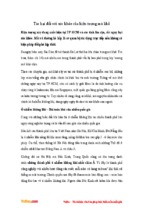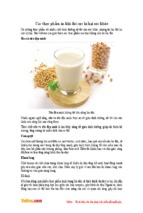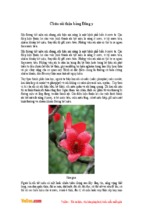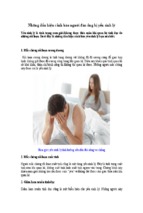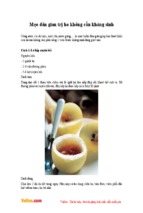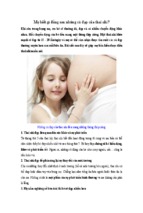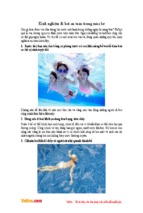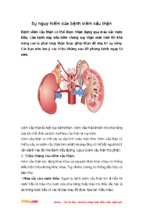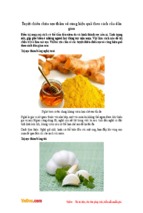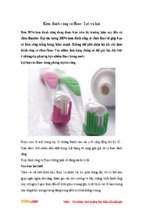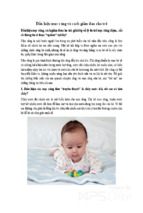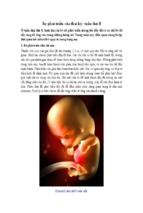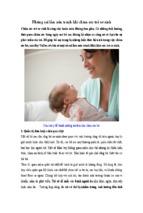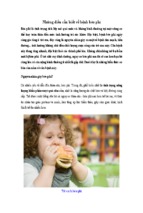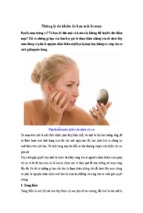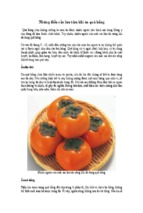24 strategies for developing a health promotion campaign
P A R T N E R S H I P
D I R E C T I O N S
Strategies for Developing a Health
Promotion Campaign
BY LOTI POPESCU AND DANIEL VERMAN
Identify the Behavior You
Want to Change
Daniel Verman, right, and “Together in Health” technical staff
prior to a broadcast.
Prior to beginning a public
health campaign, it is important to have reliable data that can be
analyzed to determine the needs of a community. Because the Constanta Health
Promotion and Health Education Department is part of the Constanta Health
Directorate, the department has access to
health statistics and is able to monitor the
health level of the community. Gathered
data help determine what health issues
need to be addressed to improve the
health status of all community members
based on real versus perceived needs within the community. Being able to monitor
C O M M O N H E A LT H • S U M M E R 2 0 0 0
the health level of the community may
also provide feedback on the success of
campaigns and allows for reaction to
trends as they occur.
After identifying a series of indicators
that suggested that the overall health of
the community needed to be addressed, a
set of projects designed to promote a
Photo courtesy of Daniel Verman.
H
ealth education, an essential part
of promoting public health policy,
offers the opportunity to work
directly for and with people from a community to change the perceptions and
beliefs of individuals. Health promotion
strategies are more successful if there is
strong communication and collaboration between public health
educators, government officials, members of a community, and the mass media.
Drawing on experiences from
the Constanta (Romania)
Health Promotion and Health
Education Department’s
“Living Healthy” campaign,
this article discusses the creation and dissemination of
clear, effective, and relevant
public health messages, one
aspect of health education.
campaign, the health promotion planners
must be committed to the team concept
and communicate effectively within the
team. Everyone must participate in and
bring his or her own experiences—as well
as the knowledge of other community
experts—to the project, while also working
to create a confident atmosphere in which
each member knows he or she has something to learn from the other members.
Interpersonal communication between team members is essential because
it provides immediate feedback about
ideas, messages, and practices. At the
same time, it helps develop momentum
that results in action. Achieving an open dialogue between
members of the health promotion team is also a good
starting point for fostering
positive interactions with your
target groups, as well as with
government officials and the
media. Ongoing contact with
local authorities and community members is vital to
achieving health promotion
goals, and the media is an effective vehicle to reach the
whole community.
healthy lifestyle was created. “Living
Healthy” is based on the belief that you
can positively influence the behavior of
individuals and get them to lead healthier lives. However, to influence behavior,
you must first be able to effectively communicate ideas about healthy lifestyles
through a community health promotion
campaign and reinforce that information
through existing resources.
Stress a Team Approach
To run a successful health promotion
24
Develop and Communicate
Your Message
A clear message is the essential
component of a good communication
strategy, and successfully getting it out
requires collaboration with newspapers,
magazines, and television and radio stations. The media represent a cost-effective
and efficient way to spread your message
throughout the entire community because each segment of the media penetrates into the population in many and
multiple ways. Press releases, press conferences, and interviews are some of the
ways to get the media interested in your
message.
Communication is about human interrelations; it incorporates learning processes,
cooperation, education, and negotiation.
Effective messages are
■ attractive—they present new and
interesting ideas in visually
appealing or eye-catching ways;
■ accessible—clear, logical, and
concise;
■ acceptable—relative to community
norms;
■ targeted—addressing a specific
group; and
■ convincing—so that people are
motivated to change.
With health messages, we indirectly
touch upon faith, personal beliefs, emotions, feelings, and attitudes. Therefore we
must be sensitive to what we say and be
vigilant about correctness of the information given to and transmitted by the media.
Continuously Reinforce Your Message
Like any good advertising campaign—be
it for a new brand of soda or STD prevention—you want members of the community to keep hearing and reading your
public health message. Since it is through
continued exposure that people take
notice of issues, it is essential that you
broadcast your messages frequently. Public health campaigns should integrate
catchy, brief messages like those found
on billboards with substantive materials,
such as newspaper articles that go into
more detail and explain why, for instance,
adopting a healthy lifestyle is a good thing
to do. In addition to providing the community with healthy lifestyle messages, it
is also important to offer information regarding medical facilities and other available resources so that they can follow up
on any health concerns they might have.
Promote Community Interaction
Each media outlet offers a way for the
community to interact directly with medical specialists to increase their knowledge. Live call-in radio or television shows
that provide immediate answers to questions and concerns are one option. Newspaper or magazine columns that give answers to questions sent in by citizens not
only provide a means for getting people
involved, they also represent the best option for addressing those health questions
about which the community is most concerned. Exploit the particular characteristics of each media type to reach your
targeted populations.
Rely on Health Experts to Answer Questions
When promoting a “message” or answering
questions about health, it is important to
use the expertise of medical and other professionals to communicate facts. Health
promotion specialists increase the confidence citizens have in the message. They
also promote the idea that knowledge is
accessible and that community members
should feel comfortable asking questions
about preventive care at medical facilities.
paigns affect public opinion, which in turn
generates greater pressure for behavior
change at all community levels, in terms of
personal behaviors, public policy, and legislation.
Examples of Media Strategies
Since people get their information from
different sources, it is important to adopt
strategies that rely on multiple media
channels. For instance, you do not want to
work only with newspapers, because many
citizens rely on radio or television for
their news and don’t read papers. The
Constanta Health Promotion and Health
Education Department has been successful in its “Healthy Living” campaign and
has employed multiple media vehicles
through which it reaches the community.
Use Television and Radio to Advance Health
Awareness
The department produces “Together for
Health,” a talk show that focuses on health
and is broadcast through the local TV station, MTC. The show airs weekly during a
Photo courtesy of Daniel Verman.
Create Clear and Attractive Messages
Daniel Verman, former AIHA Program Officer Terry Richardson, Prasaad Steiner (University
of Louisville), and Elona DeGooyer (Humana Inc.) of the Constanta/Louisville partnership
prepare for a live television show.
Affect Government Policy
Remember that media campaigns reach
government officials as well as the general public. Thus, they are a way of keeping
local authorities informed about and sensitized to health concerns. Media cam-
25
high audience hour. This TV talk show,
the only one at the Constanta county level, addresses those health issues that are
perceived to have a high level of interest in
the community. It is mostly dedicated to
preventive care
continued on page 29
C O M M O N H E A LT H • S U M M E R 2 0 0 0
Strategies for Developing a Health Promotion Campaign
continued from page 25
and health education issues such as domestic violence, STD prevention, decreasing alcohol and drug consumption,
smoking cessation, and healthy lifestyles.
The TV guests, who are specialists from
different medical areas, answer questions
posed by TV viewers. In this way, the media helps the department to efficiently
provide immediate health information
to community members.
With the help of “Radio Constanta,”
the department has developed a daily radio broadcast called “The Doctor’s Advise,” which focuses on prevention methods for different diseases. At the same radio station, every Saturday the department broadcasts a live, 30-minute
interactive (call-in) show on drug consumption and HIV prevention.
Printed Media as Promoter
The department also runs a daily column
called “Health is the Best” in the local
journal Cuget Liber (Free Thinking). The
column is dedicated to preventive care
and health education and promotion issues such as family planning methods and
prevention of STDs, communicable diseases, obesity, cardiovascular disease,
HIV/AIDS, and domestic violence. Readers of the newspaper have the opportunity to send in and receive answers to
questions about health problems from
medical specialists.
Just as the department uses collected
data to help determine which public
health areas should be addressed through
health education programs, the department also uses the media to research and
obtain opinions from community members about their health concerns. Research
results are often a starting point for additional health promotion and education
activities. Thus, those people working in
the media become healthcare collaborators as well as reporters.
The success of such strategies can be
seen in the fact that in the last year, the
local journal Cuget Liber increased in circulation and listening/viewing rates for
the hours the radio and TV shows are
broadcast went up, meaning the audience
receiving Constanta’s public health messages has grown.
Loti Popescu, MD, works in the Constanta Health
Promotion and Health Education Department. She
writes the daily “Health is the Best” column for Free
Thinking and develops a daily radio broadcast
called “The Doctor’s Advise.” Daniel Verman, MD,
is head of the Constanta Health Promotion and
Health Education Department and producer of the
TV talk show “Together for Health.” The department also broadcasts a live, 30-minute, weekly, callin talk show on drug consumption and HIV prevention at Radio Constanta, which is developed by
Verman.
- Xem thêm -


